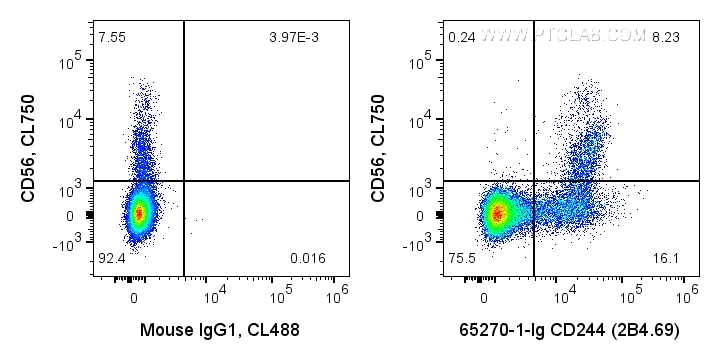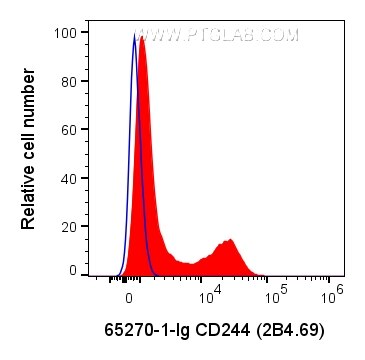Anticorps Monoclonal anti-CD244
CD244 Monoclonal Antibody for FC
Hôte / Isotype
Mouse / IgG1
Réactivité testée
Humain
Applications
FC
Conjugaison
Non conjugué
CloneNo.
2B4.69
N° de cat : 65270-1-Ig
Synonymes
Galerie de données de validation
Applications testées
| Résultats positifs en cytométrie | CMSP humaines, |
Dilution recommandée
| Application | Dilution |
|---|---|
| This reagent has been tested for flow cytometric analysis. It is recommended that this reagent should be titrated in each testing system to obtain optimal results. | |
| Sample-dependent, check data in validation data gallery | |
Informations sur le produit
65270-1-Ig cible CD244 dans les applications de FC et montre une réactivité avec des échantillons Humain
| Réactivité | Humain |
| Hôte / Isotype | Mouse / IgG1 |
| Clonalité | Monoclonal |
| Type | Anticorps |
| Immunogène | s/o |
| Nom complet | CD244 molecule, natural killer cell receptor 2B4 |
| Numéro d’acquisition GenBank | BC028073 |
| Symbole du gène | CD244 |
| Identification du gène (NCBI) | 51744 |
| Conjugaison | Non conjugué |
| Forme | Liquide |
| Méthode de purification | Purification par affinité |
| Tampon de stockage | PBS with 0.09% sodium azide. |
| Conditions de stockage | 2-8°C. |
Informations générales
CD244, also known as SLAMF4 or 2B4, is a type I transmembrane glycoprotein belonging to the signaling lymphocyte activation molecule (SLAM) family. It consists of an extracellular segment with two immunoglobulin (Ig)-like domains, a transmembrane region, and a cytoplasmic domain containing tyrosine-based motifs (PMID: 9841922; 30546369). CD244 is present on natural killer (NK) cells, γδ T cells, a subset of CD8+ T cells, monocytes, basophils, dendritic cells, and myeloid-derived suppressor cells (MDSCs) (PMID: 30546369). It binds to CD48 with high affinity and transmits stimulatory or inhibitory signals that regulate immune function (PMID: 9841922; 18523281).
Protocole
| Product Specific Protocols | |
|---|---|
| FC protocol for CD244 antibody 65270-1-Ig | Download protocol |
| Standard Protocols | |
|---|---|
| Click here to view our Standard Protocols |



